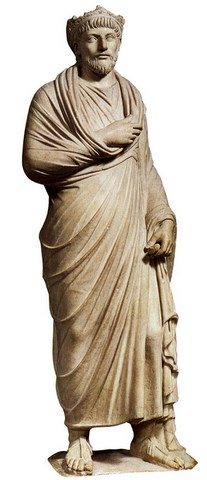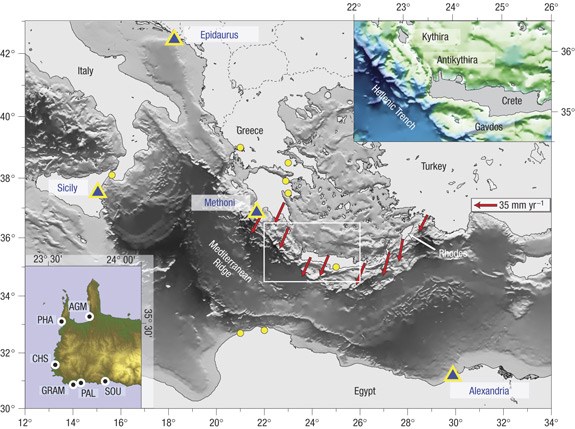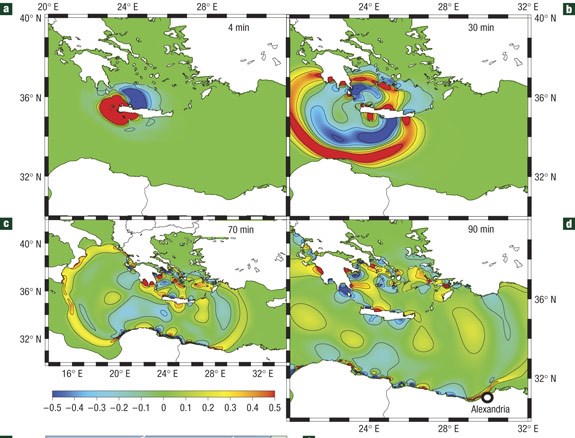What happened on July 21, 365 A.D.?
As pointed out by Gunnar Heinsohn, the Roman historian Ammianus Marcellinus (325/330-after 391 A.D.) describes in precise and vivid terms a tsunami which has been dated to have occurred on July 21, 365 A.D. :

Emperor Julian the Apostate wearing a philosopher's robe (Musée du Louvre). His death in 363 A.D. allowed for the catastrophe of July 21, 365, to be variously interpreted as a punishment and warning, should anyone consider following in his footsteps, or as a mourning of all of nature over this last great hope of Greco-Roman paganism.
15. While the usurper, whose various acts and death we have been relating, was still alive, on the 21st of July, in the first consulship of Valentinian and his brother, fearful dangers suddenly overspread the whole world, such as are related in no ancient fables or histories.
16. For a little before sunrise there was a terrible earthquake, preceded by incessant and furious lightning. The sea was driven backwards, so as to recede from the land, and the very depths were uncovered, so that many marine animals were left sticking in the mud. And the depths of its valleys and the recesses of the hills, which from the very first origin of all things had been lying beneath the boundless waters, now beheld the beams of the sun.
17. Many ships were stranded on the dry shore, while people straggling about the shoal water picked up fishes and things of that kind in their hands. In another quarter the waves, as if raging against the violence with which they had been driven back, rose, and swelling over the boiling shallows, beat upon the islands and the extended coasts of the mainland, levelling cities and houses wherever they encountered them. All the elements were in furious discord, and the whole face of the world seemed turned upside down, revealing the most extraordinary sights.
18. For the vast waves subsided when it was least expected, and thus drowned many thousand men. Even ships were swallowed up in the furious currents of the returning tide, and were seen to sink when the fury of the sea was exhausted; and the bodies of those who perished by shipwreck floated about on their backs or faces.
19. Other vessels of great size were driven on shore by the violence of the wind, and cast upon the house-tops. as happened at Alexandria; and some were even driven two miles inland, of which we ourselves saw one in Laconia, near the town of Mothone, which was lying and rotting where it had been driven.
Ammianus Marcellinus
Roman History, Book XXVI., Ch. 10, 15619.
(translated by C. D. Yonge)
Eastern Mediterranean tectonics and tsunami hazard inferred from AD earthquake
An article published in Nature Geoscience on March 9th, 2008, by B. Shaw et al., "Eastern Mediterranean tectonics and tsunami hazard inferred from the AD 365 earthquake" verifies Ammianus Marcellinus - and the other writers of Antiquity who reported about this event - beyond expectations.
Here is the abstract of this article, access to which is paying and which can not be reproduced here in its totality.
B. Shaw, N. N. Ambraseys, P. C. England, M. A. Floyd, G. J. Gorman, T. F. G. Higham, J. A. Jackson, J.-M. Nocquet, C. C. Pain & M. D. Piggott
Abstract
Historical accounts describe an earthquake and tsunami on 21 July AD 365 that destroyed cities and drowned thousands of people in coastal regions from the Nile Delta to modern-day Dubrovnik. The location and tectonic setting of this earthquake have been uncertain until now. Here, we present evidence from radiocarbon data and field observations that western Crete was lifted above sea level, by up to 10 m, synchronously with the AD 365 earthquake. The distribution of uplift, combined with observations of present-day seismicity, suggest that this earthquake occurred not on the subduction interface beneath Crete, but on a fault dipping at about 30° within the overriding plate. Calculations of tsunami propagation show that the uplift of the sea floor associated with such an earthquake would have generated a damaging tsunami through much of the eastern Mediterranean. Measurement of the present rate of crustal shortening near Crete yields an estimate of ~5,000 yr for the repeat time of tsunamigenic events on this single fault in western Crete, but if the same process takes place along the entire Hellenic subduction zone, such events may occur approximately once every 800 yr.
Go to: the article in "Nature Geoscience" - March 9th, 2008

Yellow circles mark places where the AD 365 earthquake caused destruction, and blue triangles mark places affected by the associated tsunami. Red arrows show velocities of GPS stations near the Hellenic Trench relative to Africa. The upper right inset shows the principal localities referred to in the article, and the prominent northwest–southeast bathymetric escarpment of the Hellenic Trench.

Rate of propagation of the tsunami following the earthquake of July 21, 365
The National Geographic article
National Geographic immediately reported on these results in its "news" section in an article by Mason Inman dated March 10, 2008, which we reproduce here:
Ancient Mediterranean Tsunami May Strike Again
Tsunamis like the the one that devastated ancient Alexandria in A.D. 365 may hit the Mediterranean relatively often, a new study argues. Scientists say they have pinpointed the geological fault—off the coast of the Greek island of Crete—that likely slipped during a huge quake and caused the ancient tsunami. Massive earthquakes—greater than magnitude 8—may strike the Mediterranean roughly every 800 years, the research suggests.
But other scientists say that not enough is known about these faults to predict how often such quakes might strike. They argue that the 365 disaster may have been unique. The authors of the new study measured the remains of corals, algae, and other sea life that run in a band along the coast of Crete.
"The ancient shoreline resembles a bathtub ring high above the sea on the cliff face," said Beth Shaw of the University of Cambridge in England, lead author of the study.
The findings, published in Nature Geoscience, fix a date to when western Crete was suddenly lifted up, strengthening the tie between this event and the tsunami. The team narrowed down the date of the uplift to within a few decades of 365, bolstering the idea that the upward shift happened in one sudden jolt. "Ten meters [33 feet] of uplift is quite astonishing," Shaw said. "Unexpectedly, our results confirm that all [of the] uplift did happen in the 365 A.D. earthquake."
Ancient Devastation
For at least 150 years, scientists have recognized that something unusual happened along western Crete.
When Capt. Thomas Pratt mapped the Aegean Sea in the 1850s, he noticed an ancient Roman harbor on the island sitting high and dry, 20 feet (6 meters) above the sea. Later research linked this uplift to the 365 earthquake and tsunami.
Archaeologists found skeletons in collapsed buildings with coins dating to this period. Other signs of destruction were found from this time in far-flung areas, from Cyprus to Libya. Mollusk shells from the former shoreline of Crete had also been dated to roughly the same time.
The ancient earthquake and tsunami made a strong impression on people of the time, records show. The historian Ammianus Marcellinus documented the devastating effects of the event in Alexandria, Egypt.
"The solidity of the whole earth was made to shake and shudder, and the sea was driven away," he wrote. "The mass of waters returning when least expected killed many thousands by drowning... Huge ships … perched on the roofs of houses …and others were hurled nearly two miles [3.2 kilometers] from the shore."
Separate accounts tell of earthquakes and tsunamis hitting other cities around the Mediterranean at roughly the same time.
New Fault Discovered
Shaw and colleagues used a computer model to estimate the size of tsunami waves that would have sloshed through the Mediterranean Sea in ancient times. Their results show that some coasts would have been hit harder than others, and the findings matched the historical and archaeological evidence of damage around the region. The team used measurements of the Crete shoreline to determine which fault caused the lifting.
They traced the earthquake to a previously unrecognized fault along an underwater rift called the Hellenic Trench.
The newfound fault is near a larger fault known to run along the region, where two continental plates run into each other.
"One fault is lubricated, slipping quietly without earthquakes," Shaw said. "The other slips infrequently in large earthquakes, which can cause tsunamis."
Using global positioning system (GPS) measurements of the movement of the continental plates, the team estimated how much energy builds up in the "sticky" fault and estimated it could slip and cause a massive earthquake about once every 800 years.
A Unique Disaster?
Roger Bilham is a geophysicist at the University of Colorado in Boulder who was not involved in the new study.
He said that the study presents "bad news"—namely, that any of a handful of faults in the area "could slip in megaquakes at any time.
"That the Mediterranean, with its growing coastal population in excess of 130 million … could host a large tsunami at any moment is cause for considerable unease," he added.
Paolo Pirazzoli of the National Center for Scientific Research in Meudon, France, led the first study linking the uplift in Crete to the A.D. 365 earthquake. He is unconvinced by the new estimate of earthquake frequency in the region, arguing that the ancient quake is "enigmatically unique."
He points to ancient shorelines higher up the cliffs in Crete that show the island had lifted little over the past 125,000 years, except for during the 365 event. For their part, Shaw and colleagues disagree about the age of these earlier shorelines. Their measurements put them at about 40,000 years old.
Also, Shaw added, "Earthquakes tend to repeat along the same fault or set of faults. So it would be highly unusual to have one unique event."
Go to: the National Geographic article
Saint Jerome vindicated

Saint Jerome, by Giulio Antonio Polinori, Chiesa di San Giovenale, Orvieto, Italy (ca. 1610). Long thought to have exxagerated the dimension of the events of July 21, 365, Jerome, Father of the Church, has been vindicated by recent research...
In an article in French dated 1984 on "Le raz-de-marée du 21 juillet 365, Du cataclysme local à la catastrophe cosmique," published in Mélanges de l'Ecole Française de Rome, Antiquité, T. 96, n°1 pp 423-461,* François Jacques and Bernard Bousquet list thirty documents of Antiquity referring to this tsunami. They admit that their list is partial, as they did not take into account the texts written in Syriac and in Arabic.
Nor have those texts been totally ignored by historians and archaeologists analyzing finds assigned to the fourth century in the Mediterranean Basin, even during the period in the XX century when catastrophic interpretations were systematically downgraded, if not denied.
In 1912, N. Putorti attributed the destruction of Roman baths and of a basilica in Reggio di Calabria to the events of 365 on the faith of an inscription relating to their restoration a decade later.
A. Di Vita was convinced of the occurrence of a powerful earthquake hitting Sicily and North Africa in 365. He dated to it the destruction of Sabratha (Western Tripolitania) (Lybia Antiqua, I, 1964), of the cities in Tunisia and of the celebrated villa of Piazza Armerina in Sicily (Kokalos, XVIII-XIX, 1972-1973, p.251-261; this interpretation was accepted by G. Picard, (p. 263), A. Carandini, A. Ricci and M. De Vos, Filosofiana, "La villa di Piazza Armerina," Palermo 1982, pp.52 and 54.
In "Evidenze dei Terremoti del 306-310 e 365 in Tunisia" in Antiquités Africaines, 15., 1980, p.303-307 and p.312 A. di Vita enumerates sites in Italy, from Calabria to the Alps, affected by the 365 earthquake.
In a conference in 1983, L. Menanteau even attributed to the 365 event the destruction of Belo, West of Gibraltar.
R. Rebuffat, "Cuicul, le 21 juillet 365" in Antiquités Africaines, 15, 1980 p.309-328, believes to find traces of the earthquake in Numidia and p.322, note 5, believes that it was felt in Rome as well.
In a 1965 article, R.G. Goodchild cautiously advanced the hypothesis that the 365 event affected Leptis Magna as well as the sites of Cyrene and the neighboring town of Balagrae (El Beida). ("The unfinished 'imperial' baths of Leptis Magna, Libya Antiqua,II 1965, P.15-27). "A coin hoard from "Balagrae" (El Beida) and the earthquake of A.D. 365, Libya Antiqua, III-IV, 1966-1967, p.203-211).
This chimes in with a lament of the contemporary Greco-Roman author Libanius (ca 314 - ca 394) over the death of the Emperor Julian the Apostate (who had died in 363), in which he states:
"Earth, at last, was duly informed of his loss and she honored our hero with appropriate mourning. Like a horse shaking off his rider, she has already destroyed many cities - many in Palestine, all of them in Libya. The greatest cities in Sicily lie in ruins, as do those of the Hellenes, except one [Athens]; beautiful Nicea has been felled and our own, the all beauteous one [Antioch] has been shaken and cannot trust in the future. Such is the honor rendered to him by Earth or, if you prefer, by Poseidon. But with the seasons have come famine and pestilence, harming men and beasts alike, as if it were not just that creatures might strive upon Earth, now that he is dead."
"All the cities of Libya were destroyed..." - yet, earlier earthquakes may have been at work, too, premonitory of the "big one" of 365. Nicea was reportedly hit on December 2nd, 362 (in the same time as Nicomedia, at a linear distance 40km to the North.) Palestine had been hit on May 19, 363. Both Nicea and Nicomedia, situated on the same fault, where repeatedly victims of earthquakes in 358, 368...
In their 1983 article, the two French authors, Jacques and Bousquet, do a remarkable listing the 30 separate sources telling of the 365 event in Antiquity. In keeping with the scientific attitude prevailing at the time, they are very suspiscious as to the extend, violence and dimension reported about the 365 events by contemporary and later writers, and consistently exclude the possibility that destructions in one area could have been synchroneous with those in another; they prefer to look for separate events, which, of course, occurred as well, and had been reported. They can hardly be blamed for their caution: the mere idea of a single geological event in historical times, lifting up, in one single day and movement, the Western part of the island of Crete by 10 meters would have been deemed ludicrous in the time that the article was written. It was not until almost a quarter of a century later, after all, in 2008, in articles cited above, that the fact was scientifically established.
Among the early writers upon whom Jacques and Bousquet cast doubt, none is more brilliantly vindicated than a contemporary of the event, Jerome of Stridon (347-420), a.k.a. Saint Jerome, Father of the Church. The references to the 365 event in his writings are multiple and clear, but they concern places so much distant from each other that our authors are persuaded that he is trying to "build up a case" for 365 in order to turn it into a "cosmic, universal" event, by amalgamating various, separate occurrences.
Writing fifteen years after the event, Jerome states that the walls of the city of Ar Moab - Aréopolis, to the East of the Dead Sea, were destroyed in the 365 event. He writes:
"I learned from an inhabitant of Areopolis - but the whole city is witness to this - that during a great earthquake, I was then a little child, when the seas trespassed the shores of the whole earth, during that same night, the walls of the city collapsed."
this could only have happened if the city in question had been close to the epicenter, opine Jacques and Bousquet, which cannot have been the case if it triggered a tsunami which afflicted Alexandria. (They correctly locate the epicentre to the South of Crete).
Jerome brings the tsunami of 365 all the way up the Coast of Dalmatia to the city then called Epidaurus, between today's Dubrovnik and the Bay of Kotor, now called Cavtat or Zaptat (Ragusa Vecchia in Italian) and assigns it to "the quake that shook the whole [Earth-]disk which occurred after Julian's death." Admittedly, it comes at the end of a tall tale, which has Hilarion of Gaza stopping the universal tsunami in front of an alarmed crowd of locals, and Jacques and Bousquet exclude absolutely that the tsunami which hit Alexandria in Egypt could have also reached into the Adriatic to Dubrovnik. Yet this is exactly what the team of researchers around B. Shaw of Cambridge University and her team have shown in the articles cited above.
Jacques and Bousquet detect a fine accuracy in the latter part of Jerome's description, and conclude that he must have described a tsunami which occurred there at another date, and which can only have been a local phenomenon:
"At the very moment of the earthquake that shook the whole disk which occurred after Julian's death, the seas went out of their borders and, as if God were threatening a new Deluge, or that all things were returning to the ancient Chaos, the ships were suspended on the cliffs of mountains revealed by the abyss. The inhabitants of Epidaurus, at this sight, that is, the sight of the waves shaking and the mass of the waters, and the mountains thrown to the edges of the abyss, fearing - for they understood the risk - that the city would be entirely destroyed, went to the old man... It is unbelievable at which height the sea swelling up stopped in front of him: it quivered for a long time, as if indignant to see the obstacle, then it came very slowly back to itself."
This description, Jacques and Bousquet point out, fits to a dot what happened during the February-March 1981 earthquakes in the Gulf of the Alkyonides facing Corinth (which, incidentally, Alfred de Grazia and I lived through in the not too distant Athens).
Anne-Marie de Grazia (April 2012)
* This highly interesting article is available (in French) on the site of Persée, here.

